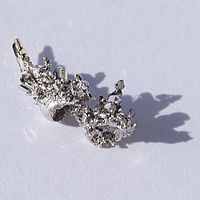
Photo from wikipedia
In this contribution, we analyze 30 years of mine development data and quantitatively identify the processes that control the grade and tenor of the mineralized rock. An assay database of… Click to show full abstract
In this contribution, we analyze 30 years of mine development data and quantitatively identify the processes that control the grade and tenor of the mineralized rock. An assay database of more than 60,000 samples was used to examine variations in ore grade and tenor of the sulfide mineralization in the J-M reef horizon of the Stillwater Complex along the strike and down the dip of the deposit in the area of the Stillwater mine. We compare these results with data from the East Boulder mine and whole-rock lithogeochemistry of samples collected along the entire strike length of the complex. We find significant variation in the composition of the reef sulfides in different spatial domains of the Stillwater mine area and between the Stillwater and East Boulder mines. Most of the variation in the grade and tenor can be explained by a variation in the mass of silicate magma with which the sulfide liquid equilibrated (i.e., R factor); however, geochemical and textural evidence suggests that parts of the reef may have experienced significant S loss following initial sulfide melt segregation. Some variability in the reef tenor and grade can be attributed to variable amounts of sulfur loss due to low-temperature hydrothermal fluids and the overestimation or underestimation of metal concentrations in reef assays due to the nugget effect. Furthermore, we address the Pd/Pt ratio of the reef samples and suggest that the lower solubility of Pt in the parental silicate melt may have caused the crystallization and removal of Pt alloys at some point before the melt reached sulfide saturation and Pt could partition into the sulfide liquid. This disparity between the prior evolution of Pt and Pd in the silicate melt resulted in the observed Pd/Pt ratio of ~3.65 across all areas of the reef—a value significantly larger than anticipated for primitive mantle-derived magmas.
Journal Title: Economic Geology
Year Published: 2020
Link to full text (if available)
Share on Social Media: Sign Up to like & get
recommendations!